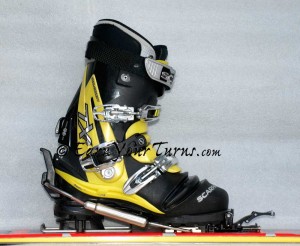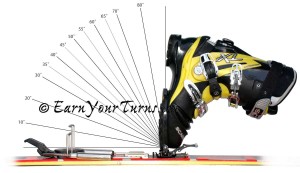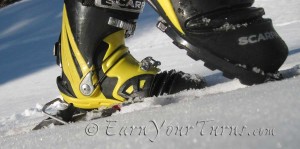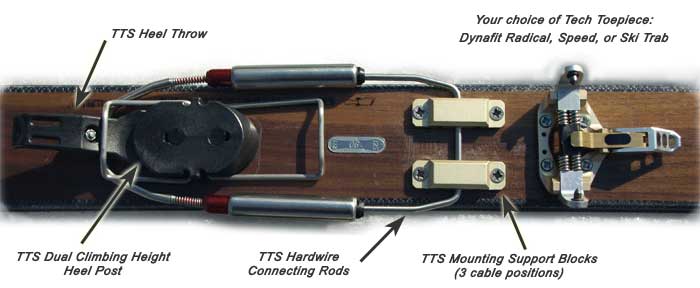To the casual observer, the updates to the Telemark Tech System look cosmetic. To a user, they transform a fledgling idea in beta form into a product worth owning, especially if you already have the boots.

The new TTS with a heel lever that latches solid and strong on the heel step of compatible boots, adjustable tele resistance and it stands flat.
Gone with this production version of TTS is the phenolic base plate which held the toe piece and cable posts in position relative to each other. The bad news is, now you get a paper template for mounting, so you better be good or get someone who is to mount these. The good news is the cable posts now come with three positioning slots, so you can make the binding more or less aggressive relative to the beta version, which is somewhat akin to Axl#2 or HH#4.
Another improvement with the cable posts is they don’t stand as high, so your foot can rest flat when you want it to. The beta posts put you mildly on your toes. It was bearable, but noticeable and is now thankfully corrected.
The borrowed Hammerheel post was an equal contributor to the toe-tippy sensation of the beta version, so the production upgrade kit for TTS comes with its own heel post. The climbing bales for it are reminiscent of the O1 – simple and effective, but lacking spring activation like the climbing peg on the Hammerheel. That is a worthwhile sacrifice to have a heel post that lets you rest your heel flat.
The second biggest improvement is the heel lever for the spring cable assembly that is dimensioned to work with a Targa heel yoke and G3 spring cartridges. It provides a good snap off the heel step of an NTN boot, something a stock G3 heel lever simply cannot do. If you insist on using a Voile spring assembly, which you may, or a Cobra spring system, use their heel levers.
Considering that a good chunk of interest in this binding will come from telemarkers who abandoned the restrictive tele heel for the skinning superiority of Dynafit, and they left while Targa’s still ruled retail sales and free pivot tele bindings were still but a dream, the TTS upgrade kit is a perfect match for you since it only provides the pieces you’re missing to make it all work together. Pull out those old Targa cable assemblies and order up a TTS upgrade kit.
Don’t have any spare Targa cables and springs? Visit your local shop. Like mine, your local shop probably has a box full of old Targa springs and heel yokes that they’ll part with for a bargain – either a 12-pack or a greenback with a picture of Andy Jackson on it.
For those who never abandoned tele but still want a super light weight rig with lots of control on the downhill, TTS delivers a complete binding too.
Many of the early adopters like yours truly were impressed with how much power TTS delivered, but not enamored with it. That’s perhaps the most important improvement — you can ratchet that power down a notch with the new cable posts.
The only problem with the adjustability of the new TTS is you have to unscrew the posts to reposition the cable. To minimize that, here’s my recommendations.
If you like a lot of cable tension, in the HH#4 range, go with the middle setting. If you don’t need that much power, by all means, start in the forward position. Switchback, Cobra, or O1 mid-stiff converts who like the resistance of their bindings will definitely prefer the forward position. If you think Axl#3 or HH#5 were just a tease, move that cable back to the last notch or just go back to using training heels.
While this is the biggest improvement to skiability for the TTS binding, it may still not fit the bill, especially if you prefer even less cable tension for turning ala Switchback or Targa. At that point you need to recognize that you’re on your own. Be aware that without a duckbill and toeplate to provide a forward stop to rotating the boot sole, there is a limit to how far you can move the cable pivot point forward without losing the ability to compress the bellow and apply pressure to the ski. It seems prudent to move the cable guides a full notch further forward so the rear position is now equivalent to the middle thus giving two less active options to chose from.
It is also worth mentioning that in the current incarnation, especially if you have a large foot, the odds of fully compressing the springs is high. The TTS binding will, more or less, force you to maintain a tall stance because of limited spring travel. However, it provides so much control maintaining a high stance shouldn’t be a problem. If you absolutely must have more spring travel distance, you’ll need to build your own custom spring assembly. Don’t rule out future options for this either.
The only thing that appears to be amiss is how to accommodate ski crampons behind the toe piece. Indeed, the cable posts will prevent that, but you can put a ski crampon behind them as long as you eliminate the forward climbing bar from the heel post. My recommendation is to use B&D crampons with the telemark accessory post.
The new cable posts deliver another unexpected benefit – reduced icing underfoot when climbing. The beta version collected a lot more snow between the toe piece and the old cable posts, perhaps because of how high they were or from the snow sticking to the base plate. Whatever the reason, the tendency for snow to build up underfoot seems to be gone, or at least reduced (see comment below).
If you’ve been waiting for TTS to grow up a bit, it has. The chubby cable posts and ill fitting heel posts are more slender, functional, and adaptable. Equally importantly the heel lever got the nose job it needed to snap on to the heel step of any compatible boot. Weight matters. Power matters. Why carry more than you need to?
I can only think of only one reason not to get a TTS binding…boots. There are not many boots to chose from and if you want the walking comfort of a T2 or SynerG you need to get a pair of F1s which are expensive. Next season’s TX is supposed to tour better than this years, but that remains to be experienced. It sure doesn’t look like much has changed other than the color and minor improvements to the buckles. The cuff range of motion appears unchanged. Keep in mind that for most conditions I’m making a big deal of a small issue since that cuff ROM is sufficient as long as you’re climbing.
My advice? Start looking for deals on Scarpa boots with bellows and tech fittings. To be specific, the TX or TX-Bro with NTN soles, or the F1 and F3 that can tele with the TTS binding (but not NTN). If we’re lucky, Crispi will actually show up in North America next season (12/13) with tech fittings on the Evo and Shiver like they said they would, but didn’t, this season. That would provide two more boot options.
One of the big concerns you may have is whether the tech toe will release prematurely. Whether you believe those who have been using it or not is a test of your faith in the tech system, or lack thereof. If you don’t believe, then it won’t work. If you do, there’s plenty of examples already out there to reinforce that faith. My own was descending a hairy, moguled and steep run that provided plenty of opportunity for the toe to let go. I locked one out so it couldn’t, but forgot to lock the other out – a simple case of anxiety induced amnesia. But neither binding released, further evidence that believing is seeing, not the other way around.
For those who have dreamed of blending Dynafit efficiency with the sensual telemark turn the Telemark Tech System is what you’ve been waiting for. It has its own set of limits, but at roughly a pound per foot with plenty of turning power there is very little not to like.
Marcus Engley demonstrates fluid style w/power using TTS:
Wasatch Ski Distribution
Telemark Tech System
Basic Conversion kit (w/o springs)
Price: $149
Full Conversion Kit (w/springs)
Price: $249
Full Binding w/ Dynafit Radical Toe
Price: $459
Related Posts:
BackcountryTalk thread – TTS, strength, weaknesses, workarounds
Verdict on Telemark Tech System
Dynafit goes bi-sensual
Day 2 on TTS
Day 1 on TTS
© 2012





32 pings
Skip to comment form
[…] Mt. Shasta. The goal was two-fold. End the season on a high note, and get some more feedback on the Telemark Tech System binding. Mt. Shasta's SE face from Hat Creek overlook. (all photos – click to […]
[…] tech fittings and either switch hit between NTN for tele and Dynafit for training heels, or give TTS a whirl. Avalanche Fundraiser The 19th Annual Black Diamond Fundraiser for the Utah Avalanche […]
[…] at this stage in the game TTS is on the bleeding edge of development so it is not without a few flaws. Chief among them are […]
[…] grip of Rottefella’s Freedom, tighten it up a bit with the Freeride, or go dyna-light with TTS. There is a good span of options from reasonable to […]
[…] for lightweight and robustness. The Mantis binding is a few grams heavier than the conventional TTS system but more robust in critical areas, reducing the chance of it breaking miles from the trail […]
[…] performance and kudos for improved touring performance. Tele mavericks have other options with the Telemark Tech System and Burnt Mountain Design’s Spike – a true step-in tele binding that can work with either […]
[…] ball-of-foot pressure point. It is also worth noting this flex phenomenon is more problematic with TTS bindings than it is with the NTN Freedom or Freeride […]
[…] is also worth noting that the dead spot in the sole is more evident when using the TTS binding with the cable tension applied at the heel, than it is when using the NTN Freedom with […]
[…] OMG TTS […]
[…] TTS binding (note the tracks). Related Posts: Day 2 with TTS Verdict on TTS Faith required w/TTS Review of TTS v2.0 © […]